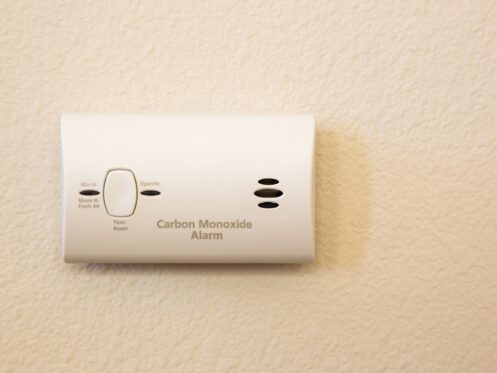As the days grow shorter and you fire up the furnace, it’s the perfect moment to make sure your safety alarms are ready. A failing detector can leave you vulnerable when winter storms knock out power or send cold drafts in. At Pipe Works Services, in Chatham, NJ, we believe a quick fall check of your smoke and carbon monoxide sensors can keep your household protected all season.
Locating Your Alarms for Maximum Coverage
When placing smoke and carbon monoxide detectors, where you put them determines how quickly they warn you of danger. Mount smoke alarms high on walls or ceilings, at least ten feet from cooking appliances, to avoid false triggers. Carbon monoxide units work best near bedrooms, so you’ll hear the alert if you’re asleep. Chemical-cell CO sensors sit low while electronic ones belong higher up, following manufacturer notes.
Walk through each room, imagining where smoke or gas would first collect. Avoid corners where air can stagnate. Spread detectors evenly across hallways and on every level of your home, including the basement. A thoughtful layout shrinks blind spots and gives you more seconds to escape if an alarm sounds.
Monthly Quick Checks to Keep You on Track
Set a reminder for a fast status check each month. Press the test button on every alarm and listen for a sharp series of beeps. If you don’t hear that sound within a few seconds, replace batteries or call a technician. While you’re at it, examine the indicator light. A green or blue glow typically signals power, whereas red flashes may point to a pending issue.
Note any chirping or irregular beeps, which often mean a battery is failing. Taking this small step on the same day each month, perhaps at the end of every month, keeps alarms from slipping off your radar. A couple of minutes of prevention grants confidence that each detector stands ready.
Deep Clean and Dust Removal
Dust, pet hair, and cobwebs can clog sensor openings and muffle alarm sounds. After testing each device, power it down by removing its cover and battery or switching off its breaker. Use a soft brush attachment on your vacuum to clear vents gently. Wipe the housing with a damp cloth to pick up lingering grime.
Take care not to push debris deeper into the circuitry. If your alarms sit near bathroom vents or kitchen doors, check for steam residue or grease on plastic surfaces and clean accordingly. Putting alarms back together after a careful wipe restores their sensitivity and keeps them from sounding when cooking pans send up harmless smoke plumes.
Battery and Backup Power Essentials
Your alarms rely on at least two power sources. Battery-operated models need fresh alkaline cells each fall. If you have sealed lithium batteries rated for ten years, still test those units monthly, even though you won’t swap out the cell. Hardwired alarms connect to home electricity but depend on backup batteries when the grid goes down.
During your fall walk-through, shut off the breaker to the alarm circuit. You should hear the battery backup kick in with a quick chirp when the main power cuts out. Fire up the breaker and watch for recovery beeps. If an alarm stays silent or hangs up, replace the backup cell right away to keep both power modes working in sync.
Replacing Aging Units Before They Fail
Manufacturers recommend swapping smoke alarms every ten years and carbon monoxide sensors every five to seven years. Over time, internal components drift out of their calibration envelope and react more slowly to danger.
Check each device’s label for its manufacture date. When yours hits its service life, remove it from its mounting plate and install a new model that meets current UL standards. Modern alarms offer quieter hush modes and lower power consumption. For CO detectors, look for electrochemical sensors that remain accurate near the end of their life span. Making renewal part of your fall routine prevents surprises when a detector silently quits working.
Smart Alarms and Connectivity Options
If you’re managing multiple detectors or want alerts while you’re away, smart alarms bring peace of mind. These units connect to your home Wi-Fi network and send push notifications to your phone. You’ll know immediately if a smoke sensor trips while you’re at work or if battery power runs low. Some models integrate with home-automation systems to flash lights or pause music when an alarm sounds.
Installation still follows the same placement rules, but setup happens through an app rather than physical switches. If you have older detectors, you can mix and match smart units with traditional ones, ensuring each wireless alarm communicates with the base stations you mount on ceilings.
Handling False Alarms Like a Pro
When an alarm chirps without a clear cause, you might reach for the silence button more quickly than you should. Instead, track the pattern. Kitchen alarms often misfire with cooking steam or burnt toast. Move those units a few feet away from the stove and open a window while you cook. Bathroom detectors can react to steamy showers, so add steam guards or a fan to vent moisture.
Dust inside the sensor can also trigger nuisance trips, so deep cleaning fixes that problem permanently. Keeping an incident log, including date, time, and suspected cause, helps you spot recurring issues and decide whether relocation or a different model fits your home better.
Record Keeping and Scheduling Next Steps
A written log keeps you honest about maintenance. Note each test date, battery change, unit replacement, and professional inspection. Use a simple notebook or an entry in your digital calendar that pings you every six months. When a technician visits to service your heating, cooling, or plumbing system, ask them to glance at alarms and check mounting brackets.
Over the years, you’ll build a history that highlights any problem trends, perhaps a particular hallway detector trips more often, or a CO sensor always needs battery swaps early. Armed with that data, you can fine-tune placement and upgrade to models that hold up better in your home’s environment.
Incorporating Family Drills for Real-World Readiness
Running through a drill helps everyone know what to do when an alarm sounds. Choose a weekend afternoon and treat it like the real deal. Start by walking each family member to the nearest exit; windows count if the main doors are blocked. How long does it take for everyone to reach an agreed meeting spot, such as the mailbox or a big tree?
Practice turning off gas or electricity, if your home plan calls for that. Include young children by turning it into a game of follow-the-leader, so they look forward to participating. Repeat these drills twice a year, in spring and fall when the clocks change, to keep the routine fresh.
Fall into a Safer Season
Giving your smoke and CO detectors a quick once-over now spares you the panic of a midnight alarm. This autumn ritual takes minutes but has a lasting impact on your home’s safety. If you need an expert hand or want to upgrade to smart-monitoring devices, Pipe Works Services offers installation and inspection services that make staying protected effortless. Ready to lock in your fall check and safeguard your family? Call Pipe Works Services today and breathe easier tonight.





